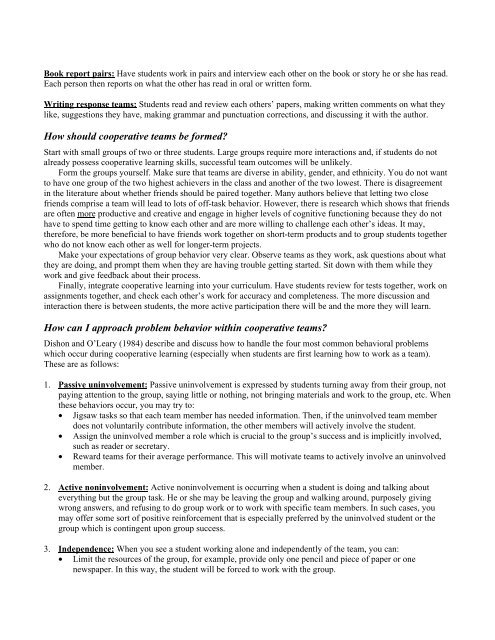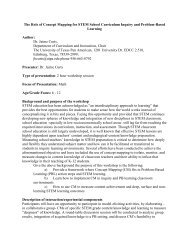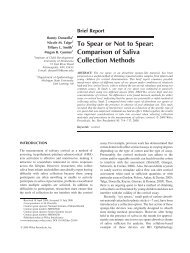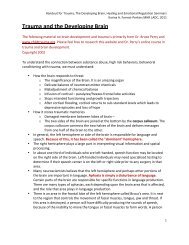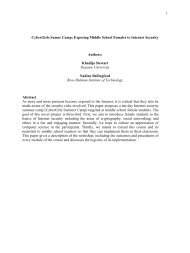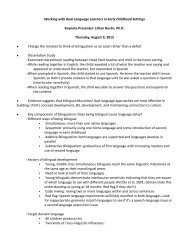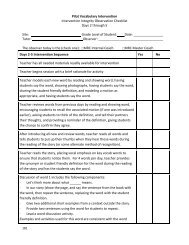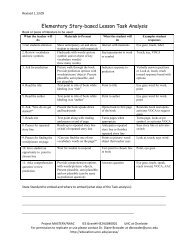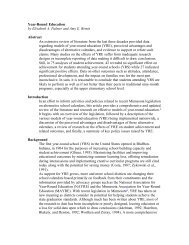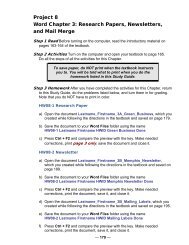Introduction to Positive Ways of Intervening with Challenging Behavior
Introduction to Positive Ways of Intervening with Challenging Behavior
Introduction to Positive Ways of Intervening with Challenging Behavior
Create successful ePaper yourself
Turn your PDF publications into a flip-book with our unique Google optimized e-Paper software.
Book report pairs: Have students work in pairs and interview each other on the book or s<strong>to</strong>ry he or she has read.<br />
Each person then reports on what the other has read in oral or written form.<br />
Writing response teams: Students read and review each others’ papers, making written comments on what they<br />
like, suggestions they have, making grammar and punctuation corrections, and discussing it <strong>with</strong> the author.<br />
How should cooperative teams be formed?<br />
Start <strong>with</strong> small groups <strong>of</strong> two or three students. Large groups require more interactions and, if students do not<br />
already possess cooperative learning skills, successful team outcomes will be unlikely.<br />
Form the groups yourself. Make sure that teams are diverse in ability, gender, and ethnicity. You do not want<br />
<strong>to</strong> have one group <strong>of</strong> the two highest achievers in the class and another <strong>of</strong> the two lowest. There is disagreement<br />
in the literature about whether friends should be paired <strong>to</strong>gether. Many authors believe that letting two close<br />
friends comprise a team will lead <strong>to</strong> lots <strong>of</strong> <strong>of</strong>f-task behavior. However, there is research which shows that friends<br />
are <strong>of</strong>ten more productive and creative and engage in higher levels <strong>of</strong> cognitive functioning because they do not<br />
have <strong>to</strong> spend time getting <strong>to</strong> know each other and are more willing <strong>to</strong> challenge each other’s ideas. It may,<br />
therefore, be more beneficial <strong>to</strong> have friends work <strong>to</strong>gether on short-term products and <strong>to</strong> group students <strong>to</strong>gether<br />
who do not know each other as well for longer-term projects.<br />
Make your expectations <strong>of</strong> group behavior very clear. Observe teams as they work, ask questions about what<br />
they are doing, and prompt them when they are having trouble getting started. Sit down <strong>with</strong> them while they<br />
work and give feedback about their process.<br />
Finally, integrate cooperative learning in<strong>to</strong> your curriculum. Have students review for tests <strong>to</strong>gether, work on<br />
assignments <strong>to</strong>gether, and check each other’s work for accuracy and completeness. The more discussion and<br />
interaction there is between students, the more active participation there will be and the more they will learn.<br />
How can I approach problem behavior <strong>with</strong>in cooperative teams?<br />
Dishon and O’Leary (1984) describe and discuss how <strong>to</strong> handle the four most common behavioral problems<br />
which occur during cooperative learning (especially when students are first learning how <strong>to</strong> work as a team).<br />
These are as follows:<br />
1. Passive uninvolvement: Passive uninvolvement is expressed by students turning away from their group, not<br />
paying attention <strong>to</strong> the group, saying little or nothing, not bringing materials and work <strong>to</strong> the group, etc. When<br />
these behaviors occur, you may try <strong>to</strong>:<br />
• Jigsaw tasks so that each team member has needed information. Then, if the uninvolved team member<br />
does not voluntarily contribute information, the other members will actively involve the student.<br />
• Assign the uninvolved member a role which is crucial <strong>to</strong> the group’s success and is implicitly involved,<br />
such as reader or secretary.<br />
• Reward teams for their average performance. This will motivate teams <strong>to</strong> actively involve an uninvolved<br />
member.<br />
2. Active noninvolvement: Active noninvolvement is occurring when a student is doing and talking about<br />
everything but the group task. He or she may be leaving the group and walking around, purposely giving<br />
wrong answers, and refusing <strong>to</strong> do group work or <strong>to</strong> work <strong>with</strong> specific team members. In such cases, you<br />
may <strong>of</strong>fer some sort <strong>of</strong> positive reinforcement that is especially preferred by the uninvolved student or the<br />
group which is contingent upon group success.<br />
3. Independence: When you see a student working alone and independently <strong>of</strong> the team, you can:<br />
• Limit the resources <strong>of</strong> the group, for example, provide only one pencil and piece <strong>of</strong> paper or one<br />
newspaper. In this way, the student will be forced <strong>to</strong> work <strong>with</strong> the group.


